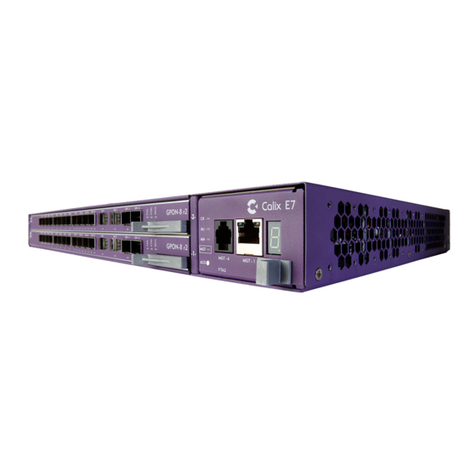10
Proprietary Information: Not for use or disclosure except by written agreement with Calix.
© Calix. All Rights Reserved.
xDSL Subscriber Access Support
The Calix E-Series Ethernet service platform leverages VDSL2 and ADSL2+ technology,
along with an Ethernet switching fabric, to perform L2 aggregation / switching and layer-3-
aware service delivery. Up to two dedicated 10 Gigabit and four 2.5 or 1 Gigabit Ethernet
uplinks can be leveraged to provide high capacity service delivery on a per-chassis basis.
E7-2 VDSL2-48 Overlay Line Card
Interfaces:
48x DSL Overlay ports with corresponding 600- or 900-Ohm integrated splitters
Four 1GE / 2.5GE SFP MSA sockets, and two 1GE / 10GE SFP+ MSA sockets
Features:
The VDSL2-48 also supports pair bonding in both ADSL2+ and VDSL2 modes.
One VDSL2-48 line card can be installed in an E7-2 chassis.
Integrated splitters provide a means to extract analog voice form the service loop and
terminate it on an existing DLC or analog POTS port on a switch line bay. One E7-2
VDSL2-48 line card can be plugged into a Calix E7-2 shelf to create a compact, high
density DSL overlay node, with Ethernet aggregation and transport, ideal for copper
based delivery of IP services leveraging existing POTS infrastructure, across the access
network.
Rev 13 and above of the VDSL2-48 card supports 600/900 Ω impedance, compatible
with all E7 releases. There is no need to select between 600 and 900 Ω impedance and
the splitter design accommodates either impedance without configuration.
POTS interfaces of the VDSL2-48 line card have the following characteristics:
Impedance of 600 Ω + 2.16 μf, supporting ETSI based loop plants
Impedance of 900 Ω + 2.16 μf, supporting ANSI based loop plants
Loop current of up to 25mA (during normal operation), and 18mA (during battery
backup)
E7-2 VDSL2-48 r2 Overlay Line Card
This card is backward compatible with the original E7-2 VDSL2-48 Overlay line card.
E7-2 VDSL2-48C Combo Line Card
Interfaces:
48x Combo DSL and POTS ports, two 1GE / 2.5GE SFP MSA sockets
Two 1GE/10GE SFP+ MSA sockets




























